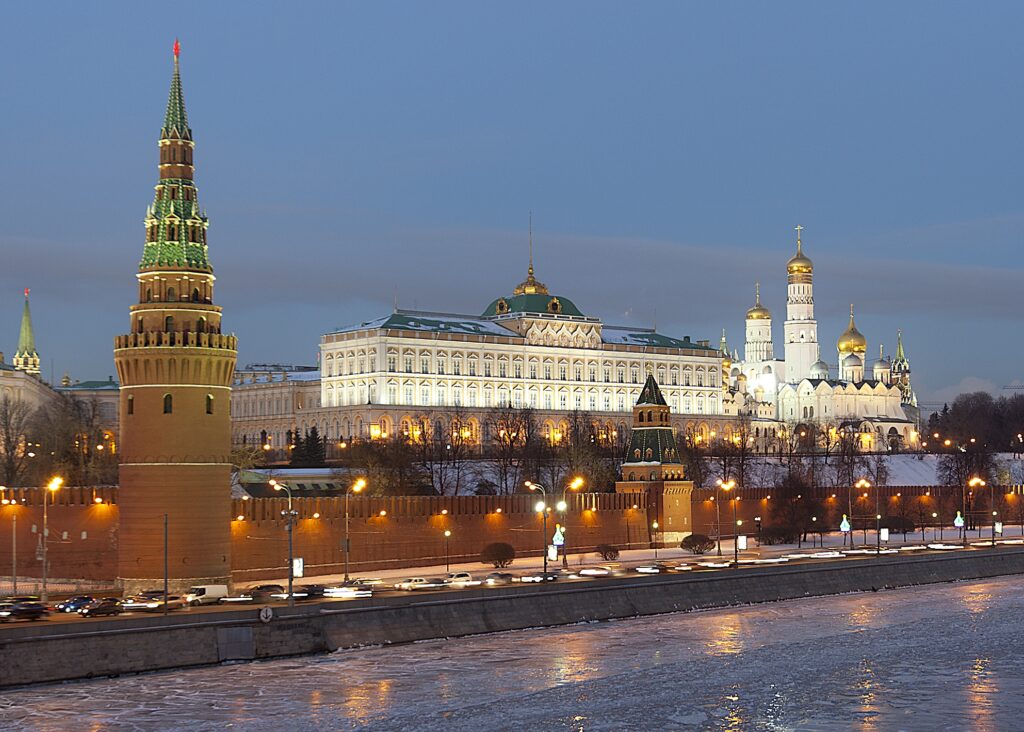The Kremlin, located in the heart of Moscow, Russia, is one of the most famous and historically significant architectural complexes in the world. Its name “Kremlin” translates to “fortress” or “citadel,” reflecting its original military purpose. Today, it serves as the official residence of the President of Russia and is the administrative center of the Russian government.

The history of the Kremlin dates back to the late 12th century when Prince Yuri Dolgorukiy established a wooden fortification on the site overlooking the Moskva River. Over the centuries, it underwent numerous expansions, reconstructions, and renovations, gradually transforming into the grand complex we see today.
The Kremlin’s architectural ensemble represents a fusion of various styles, reflecting the diverse periods and rulers that have left their mark on the fortress. The thick red-brick walls, adorned with crenellations and towers, encircle the Kremlin, providing an imposing and majestic appearance. The Spasskaya Tower, with its iconic clock and ruby-red star, stands out as one of the most recognizable structures.
Inside the Kremlin walls, a wealth of magnificent buildings await exploration, each with its own historical significance. The Assumption Cathedral, the Archangel’s Cathedral, and the Annunciation Cathedral exemplify Russian medieval architecture, known for their exquisite frescoes and intricate decor.
The Grand Kremlin Palace, an example of neoclassical architecture, serves as the official residence of the President of Russia. Its opulent halls and chambers host state functions, receptions, and diplomatic meetings, reflecting the splendor of Russia’s leadership.
The Senate Building and the State Kremlin Palace are other notable structures within the complex. The latter serves as a major venue for cultural events, concerts, and performances, showcasing its modern versatility as an entertainment hub.
Beyond its architectural marvels, the Kremlin holds immense historical and political significance. Throughout its existence, it has witnessed the rise and fall of numerous Russian rulers, witnessed coronations and weddings, and played a pivotal role in shaping the nation’s fate.
The Kremlin’s history is intertwined with Russia’s turbulent past. It has survived fires, invasions, and sieges, standing as a symbol of resilience and determination. Recognizing its cultural and historical importance, the Kremlin was designated a UNESCO World Heritage Site, drawing millions of visitors annually from around the world.
As the seat of power in Russia, the Kremlin is vital to the nation’s governance. It houses numerous government offices, ministries, and institutions, including the Russian presidential administration. The State Duma and the Federation Council, the two houses of the Federal Assembly of Russia, also convene in the Kremlin.
In addition to its political significance, the Kremlin hosts a variety of cultural events and celebrations that showcase Russia’s rich heritage. The annual Victory Day Parade on May 9th, marking the end of World War II, is among the most prominent events held in the Kremlin, attracting dignitaries and spectators from across the globe.
The Kremlin’s significance extends beyond its physical presence, making it a symbol of Russian identity, authority, and history. Its enduring legacy continues to captivate and fascinate people worldwide, and it remains an iconic landmark that represents the essence of Russia’s cultural and political heritage.
